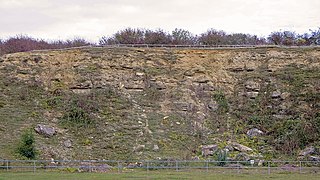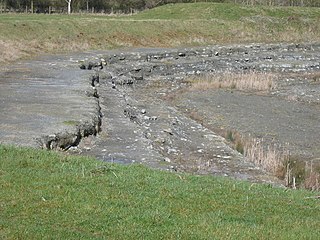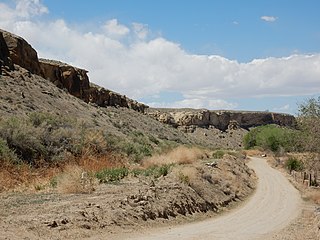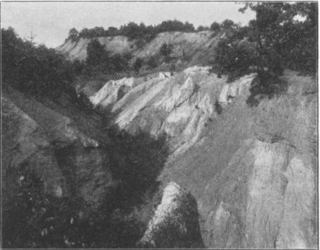
Weald Clay or the Weald Clay Formation is a Lower Cretaceous sedimentary rock unit underlying areas of South East England, between the North and South Downs, in an area called the Weald Basin. It is the uppermost unit of the Wealden Group of rocks within the Weald Basin, and the upper portion of the unit is equivalent in age to the exposed portion of the Wessex Formation on the Isle of Wight. It predominantly consists of thinly bedded mudstone. The un-weathered form is blue/grey, and the yellow/orange is the weathered form, it is used in brickmaking.
The Reading Formation is a geologic formation in southern England. It dates to the Paleocene period, and is part of the Lambeth Group. It overlies the London Basin and is below the Harwich Formation. The formation is composed of "a series of lenticular mottled clays and sands, here and there with pebbly beds and masses of fine sand converted into quartzite. These beds are generally unfossiliferous."

Manchurochelys is an extinct genus of turtle. It existed during the early Cretaceous of what is now northeast China. It has been found in the Jianshangou Bed of West Liaoning's Yixian Formation. However, it is a rarely found fossil.

The Wessex Formation is a fossil-rich English geological formation that dates from the Berriasian to Barremian stages of the Early Cretaceous. It forms part of the Wealden Group and underlies the younger Vectis Formation and overlies the Durlston Formation. The dominant lithology of this unit is mudstone with some interbedded sandstones. It is part of the strata of the Wessex Basin, exposed in both the Isle of Purbeck and the Isle of Wight. While the Purbeck sections are largely barren of vertebrate remains, the Isle of Wight sections are well known for producing the richest and most diverse fauna in Early Cretaceous Europe.

The Forest Marble is a geological formation in England. Part of the Great Oolite Group, it dates to the late Bathonian stage of the Middle Jurassic.
Parviraptor is a genus of squamate containing one species, Parviraptor estesi, from the Late Jurassic (Tithonian) or Early Cretaceous (Berriasian) Purbeck Limestone Formation of Dorset, England. A second species, Parviraptor gilmorei, was described from the Late Jurassic Morrison Formation of Western North America; it was present in stratigraphic zone 4. However, the second species was subsequently transferred to a separate genus Diablophis. An indeterminate species is known from the Bathonian aged Kirtlington Mammal Bed.

The Castlegate Sandstone is a Mesozoic geologic formation in the United States. Dinosaur remains are among the fossils that have been recovered from the formation, although none have yet been referred to a specific genus.

The Cornbrash Formation is a Middle Jurassic geological formation in England. It ranges in age from Bathonian to Callovian, the uppermost part of the Middle Jurassic. Dinosaur remains are among the fossils that have been recovered from the formation, although none have yet been referred to a specific genus. The name Cornbrash is an old English agricultural name applied in Wiltshire to a variety of loose rubble or brash which, in that part of the country, forms a good soil for growing corn. The name was adopted by William Smith for a thin band of shelly limestone which, in the south of England, breaks up in the manner indicated. Although only a thin group of rocks, it is remarkably persistent; it may be traced from Weymouth to the Yorkshire coast, but in north Lincolnshire it is very thin, and probably dies out in the neighborhood of the Humber. It appears again, however, as a thin bed in Gristhorpe Bay, Cayton Bay, Wheatcroft, Newton Dale and Langdale. In the inland exposures in Yorkshire it is difficult to follow on account of its thinness, and the fact that it passes up into dark shales in many places the so-called clays of the Cornbrash, with Avicula echinata. The Cornbrash is of little value for building or road-making, although it is used locally; in the south of England it is not oolitic, but in Yorkshire it is a rubbly, marly, frequently ironshot oolitic limestone. In Bedfordshire it has been termed the Bedford limestone.

The Pictured Cliffs Formation is a Campanian geologic formation in the San Juan Basin of New Mexico. Dinosaur remains are among the fossils that have been recovered from the formation, although none have yet been referred to a specific genus.
The Hampen Formation is a Jurassic geological formation of Bathonian age found in central Southern England. Dinosaur remains diagnostic to the genus level are among the fossils that have been recovered from the formation. This formation was formerly known as the Hamden Marly Formation or the Hamden Marly Beds.

The Patuxent Formation is a Cretaceous geologic formation of the Atlantic coastal plain.

The Casselman Formation mapped sedimentary bedrock unit in Pennsylvania, Maryland, and West Virginia, of Pennsylvanian age. It is the uppermost of two formations in the Conemaugh Group, the lower being the Glenshaw Formation. The boundary between these two units is the top of the marine Ames Limestone. The Conemaugh Group overlies the Upper Freeport coal bed of the Allegheny Formation and underlies the Pittsburgh coal seam of the Monongahela Group.

The Glenshaw Formation is a mapped sedimentary bedrock unit in Pennsylvania, Maryland, West Virginia, and Ohio, of Pennsylvanian age. It is the lower of two formations in the Conemaugh Group, the upper being the Casselman Formation. The boundary between these two units is the top of the marine Ames Limestone. The Conemaugh Group overlies the Upper Freeport coal bed of the Allegheny Formation and underlies the Pittsburgh coal seam of the Monongahela Group.
The Weaver Beds is a geologic formation in England. It preserves fossils dating back to the Carboniferous period.
The Scremerston Formation is a geologic formation in England. It preserves fossils dating back to the Carboniferous period.
The Colsterdale Marine Beds is a geologic formation in North Yorkshire, England. It is exposed in Colsterdale and upper Nidderdale, and preserves fossils dating back to the Carboniferous period.
The Carstone Formation is a geological formation in England. It preserves fossils dating back to the Albian stage of the Cretaceous period. It predominantly consists of "greenish-brown, thick-bedded, cross-bedded, oolitic ferruginous sandstone".

The Ringstead Coral Bed is a geological formation with fossilized coral in England. It preserves fossils dating back to the Jurassic period. The beds are exposed at Ringstead Bay in Dorset, on the Jurassic Coast, hence the name.
The Oldhaven Beds is a geologic formation in England. It preserves fossils dating back to the Paleogene period.
The Elton Beds is a geologic formation in England and Wales. It preserves fossils dating back to the Silurian period.











